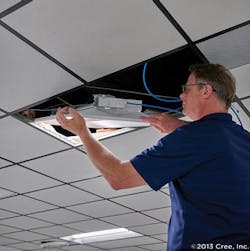Intelligent building cabling solutions support PoE lighting for a better education environment
By Betsy Conroy, Siemon
The Internet of Things (IoT) is changing the way of life as we know it. Low-voltage devices are now converging on a single unified physical infrastructure, allowing for the collection of large amounts of data that can be exchanged between integrated building systems and analyzed to make business decisions that help save operating expenses while improving efficiency and user experience. To further accelerate digital transformation and extend the benefits of the IoT throughout facilities, Cisco recently introduced their Digital Ceiling framework that converges multiple building networks-lighting, heating and cooling, IP video, IoT sensors and much more-on a secure and intelligent network platform.
Included in the Cisco Digital Ceiling partner ecosystem are a variety of industry-leading partners to help build a Digital Ceiling, including lighting, building automation, cabling and software providers. A key aspect of the Digital Ceiling includes the use of Cisco network switches delivering Universal Power over Ethernet (UPOE) that extends the IEEE Power over Ethernet Plus (PoE+) standard to deliver up to 60 Watts to low-voltage devices, including PoE-powered LED lighting fixtures with sensors that have the potential to provide 85-percent lower energy costs.
Siemon, a global market leader in the design and manufacturing of high-performance, low-voltage infrastructure solutions, is currently the only end-to-end provider of cabling systems within the Cisco Digital Ceiling partner ecosystem. Unequivocally aligned with Cisco’s Digital Ceiling, Siemon’s ConvergeIT Cabling Solutions include advanced copper shielded cables and connectivity with patented innovative technologies that provide superior support for PoE-enabled devices.
Siemon recently teamed up with Cisco and Cree, a leading provider of advanced PoE lighting solutions and also a Cisco Digital Ceiling Partner, to deliver an innovative PoE lighting system for a Mobile, Alabama school as a pilot program to collect and analyze critical data-all to demonstrate the overall savings and benefits for future district-wide deployments.
In light of the possibilities
When David Akridge, executive manager of IT at Mobile County Public School System, attended the 2015 Interop Expo in Las Vegas, he was intrigued by something he noticed at the Cisco booth-an LED light connected to a switch.
“I knew right away that it was a PoE-powered LED light, and after talking with Cisco about their Digital Ceiling initiative, I couldn’t get all of the possibilities of PoE lighting out of my head,” says Akridge. “Not only are we not afraid to pioneer within our school system, but I have always had a disdain for traditional fluorescent lighting-especially in a classroom environment. With LED lighting, I can finally see the light at the end of the tunnel.”
While fluorescents have provided a constant source of light for more than a decade, studies indicate that fluorescent lighting can lead to headaches and eye strain, as well as potential seizures for those with photosensitive epilepsy. Not only do LEDs light eliminate these health concerns, they are also a much more environmentally sustainable option. LED lights consume nearly half the electricity of equivalent fluorescents, emit less than half the carbon emissions of fluorescents, and contain no hazardous mercury. With a lifespan nearly five times that of fluorescents, combined with improved durability and no sensitivity to temperature or humidity, LEDs also greatly reduce maintenance costs.
By implementing Cree PoE lighting as a pilot project on one floor at the district’s Clark-Shaw Magnet Middle School, named a Blue Ribbon School for 2015 by the U.S. Department of Education, Akridge can carefully analyze the impact of new lighting system on energy consumption, student productivity and overall operational savings and efficiencies compared to another floor in the same school that uses fluorescents.
“Pilot deployments make sense because it’s hard to analyze the benefits of any technology unless you can experience it with your own school, your own students and your own teachers,” says Akridge. “We have 8th graders in the same classes on both the floor with PoE lighting and on the floor with traditional fluorescents. This allows me to do a class-by-class comparison. We will be comparing assessment test scores, grades and overall classroom behavior and participation, as well as carefully monitoring the energy consumption and response to emergency incidents.”
Through the use of Cree LED fixtures outfitted with occupancy and temperature sensors, the Mobile Public School System can ensure that lights are on only when needed and they can integrate the networked light fixtures with other building automation systems (BAS) such as HVAC to reduce unnecessary energy consumption. The ability to connect PoE lighting to the network also allows the school to integrate lighting control with networked security systems and activate blinking patterns for emergency response.
“We are working closely with the Digital Ceiling partners on this project to integrate the lights with our security systems so that we can have specific blinking patterns for certain types of emergencies,” says Akridge. “For example, if there is an active shooter in the building, we want to minimize the use of the paging system and the intruder’s knowledge. We can use the lights and specific blinking patterns to provide a private warning message to staff and students. Because each fixture is a node on the network with its own IP address, we can also identify the exact location of any detected movement.”
Akridge hopes to have the information and analysis needed to demonstrate the productivity and cost savings for justification of PoE lighting throughout the entire school system, including two new schools currently in the planning stages.
Patented technology in the zone
Once the decision was made to deploy PoE lighting at Clark-Shaw Magnet Middle School, Siemon together with Cisco and Cree designed a deployment strategy that would offer the greatest flexibility and performance with the least amount of cost and labor. Based on guidance from Cree, the design consisted of about 145 PoE lighting fixtures. This ended up being about 30 percent fewer lights than the original fluorescent lighting design in the space, which was ultimately determined to be over-illuminated.
The PoE lighting system was also deployed using a zone cabling design that consists of horizontal cables run from Cisco UPOE switches in the telecommunications rooms (TR) to intermediate connection points housed in a zoned enclosure located in the ceiling space. From the zone enclosure, each PoE lighting node was connected via shorter, easy-to-manage connections.
“We design PoE lighting projects using a zone cabling approach because it supports a more-rapid deployment, which is especially important when you consider the sheer number of lights that can go into a facility,” says Bob Allan, global business development manager for intelligent buildings and strategic alliances at Siemon. “With zone cabling, the fixtures are easily connected using patch cords from outlets mounted in the zone unit enclosure instead of connected to an entire length of horizontal cabling from the switch in the TR.”
Zone cabling also significantly simplifies any reconfiguration of fixtures or addition of new fixtures with less disruption, requiring only a short connection to the zone enclosure. In addition, a zone cabling design allows the option of deploying factory preterminated and tested cable assemblies from the TR to the zone to support quick implementation, performance exceeding field terminations, and reduced field testing times.
For the zone cabling design, Siemon deployed their new 24-port MAX Zone Unit Enclosure. Part of Siemon’s line of ConvergeIT Cabling Solutions for Intelligent Buildings, the 24-port MAX Zone Unit Enclosure accepts up to 24 ports using Siemon copper or fiber MAX outlets, Z-MAX Category 6A outlets or TERA Category 7A outlets. It features foam gasketing to minimize vibration and prevent dust ingress, a fully removable cover for improved access to connections, and easy-to-remove knockouts to facilitate routing cables in and out of the enclosure. The enclosure is also designed to meet UL’s plenum rating requirements, which allowed the 24-Port MAX Zone Unit Enclosure to be mounted above the ceiling in the air-handling space at Clark-Shaw Magnet School.
The cabling infrastructure used to connect the PoE lighting nodes comprises Siemon’s Z-MAX Category 6A shielded systems, including Z-MAX Category 6A shielded cable terminated to Z-MAX shielded jacks housed in the 24-Port MAX Zone Unit Enclosures and solid shielded patch cords used to make the final connection.
The Z-MAX Category 6A shielded system is designed to achieve superior transmission performance and provide maximum reliability for remote power applications such as UPOE. Unmating a jack-plug connection under a UPOE load produces an arc that erodes the gold-plated jack-plug contact surfaces at the arcing location. When this erosion occurs in the area of the fully mated position, the result is an unreliable connection. Siemon’s Z-MAX jacks are designed with a patented curved or “crowned” contact geometry that places arcing damage to both the plug and jack contacts away from the final mated position for superior reliability of PoE. The design of the Z-MAX jacks also eliminates risk of permanent contact deformation due to mechanical stress. In fact, Siemon’s Z-MAX connecting hardware has been independently certified for compliance to the IEC-60512-99-001 standard, which was specifically developed to ensure reliable connections for remote powering applications deployed over balanced twisted-pair cabling.
In addition to the patented jack contact geometry, Siemon’s Z-MAX Category 6A system includes higher-quality shielded F/UTP cable that is qualified for mechanical reliability up to 75 degrees Celsius (167 degrees Fahrenheit). This is important because remote power applications like UPOE can cause heat buildup inside cable bundles that increases insertion loss (i.e., signal attenuation). Both TIA and ISO/IEC specify an insertion loss de-rating factor for use in determining the maximum channel length at temperatures above 20 deg. C (68 deg. F). Using higher-quality shielded Category 6A cables like Siemon’s Z-MAX Category 6A system can help overcome this obstacle, reducing any length de-rating and allowing the flexibility to support longer channel lengths where needed. In fact, Siemon’s Z-MAX Category 6A shielded cable requires less than one-fifth the length de-rating than minimally compliant Category 6A UTP cables.
Savings and a better student experience
The installation of the Cree PoE lighting system was completed in just a few short days by Sunrise Network Services (www.sns-usi.com), a leading structured cabling company founded in 2003. Because Josh Bowie, RCDD, owner of Sunrise Network Services, saw the opportunity to learn more about PoE lighting deployments and develop relationships within the Cisco Digital Ceiling Partner Ecosystem, his team donated their time and expertise for the installation.
With the installation at Clark-Shaw Magnet School now complete, Mobile Public School System is now starting to collect the data needed to analyze the success of the PoE lighting pilot installation. They have also already witnessed up-front savings by using UPOE for power rather than traditional AC power runs, as well as via the reduced maintenance offered by the LED technology.
“I was amazed at the cost savings to wire the lights with low-voltage Ethernet cables versus traditional AC power,” says Akridge. “The installation itself was very quick, and we can use the cables for any network device if necessary. The reliability of the LED lights will also improve overall productivity of our maintenance staff as they will no longer have to spend as much time replacing bulbs. I’ll be pushing up daisies in the cemetery before these fixtures ever need to be changed.”
In recent years, the Mobile Public School System has implemented several energy-saving initiatives to ultimately cut about $5 million out of their utility costs. While Akridge is confident they will realize even greater savings with PoE lighting, the ability to improve the overall learning environment and safety and security of students is his greatest objective.
“While saving money is great, I’m more interested in what PoE lighting can do for education,” he says. “Students at the school have already commented on the LED lighting and its ability to improve their overall mood. The data does not lie, and if I can show how PoE lighting improves our kids and our electric bill, it’s a no-brainer.”
Betsy Conroy is global marketing communications manager for Siemon. Information about how Siemon’s ConvergeIT Cabling Solutions for Intelligent Buildings support Cisco’s Digital Ceiling can be found at www.siemon.com/convergeit.
Cabling for PoE lighting: Design and deployment guidelines
A zone cabling design for PoE lighting such as was deployed at the Clark-Shaw Magnet Middle School is very similar to that used for building automation systems and other IP devices. Siemon provided recommended guidelines for zone cabling and coverage area planning in the May 2016 issue of Cabling Installation & Maintenance magazine. Because of the high number of PoE lighting devices within a space and the static nature of lighting (i.e., few adds, moves and changes), Siemon recommends that the zone cabling system for PoE lighting overlay the zone cabling system for other building automation and IP devices and that dedicated zone enclosures be provided for PoE lighting device connections. If additional outlets beyond what are available at the dedicated PoE lighting zone enclosure are needed, they can be accessed from an adjacent zone enclosure used to support other IP devices.
Due to the density of PoE lighting devices, which is typically about 250 2ftx2ft troffers per 930m2 (10,000 ft2) space, Siemon also recommends that the optimum PoE lighting devices coverage area is an 18mx18m (60ftx60ft) square or grid. The dedicated PoE lighting zone enclosure should be centrally located within the coverage area, and the recommended number of outlets in the enclosure is dependent upon the number and size of the PoE lighting devices and type of system. Siemon recommends that the number of available connections within the zone enclosure should be no less than 24 (e.g. for small deployments or for enclosures located on a wall) and should not exceed 96 to ensure that cable bundle size are manageable and that remote powering current-induced heat buildup within cable bundles is controlled.
Ideally, zone enclosures should be positioned at least 30m (100 ft) from the TR. If lighting coverage areas are in close proximity to a TR, PoE lighting devices may be connected to equipment outlets instead of via outlets in a zone enclosure. In addition, when PoE lighting devices are located more than 5m (16 ft) from the zone enclosure, using an equipment outlet to connect the device can facilitate administration, simplify testing, eliminate the need to install long lengths of cable when devices are added, and remove concerns surrounding removal of abandoned cable when devices are taken out of service.
In summary, several variables must be considered prior to identifying the right PoE lighting system for an environment, and the process to design and deploy lighting devices in coverages areas can be complex and confusing. The use of digital lighting partners that are certified cabling design and installation experts can help ensure that customers receive a cost-effective, manageable infrastructure design to support the density of PoE lighting devices.
Valerie Maguire is global sales engineer with Siemon (www.siemon.com).








